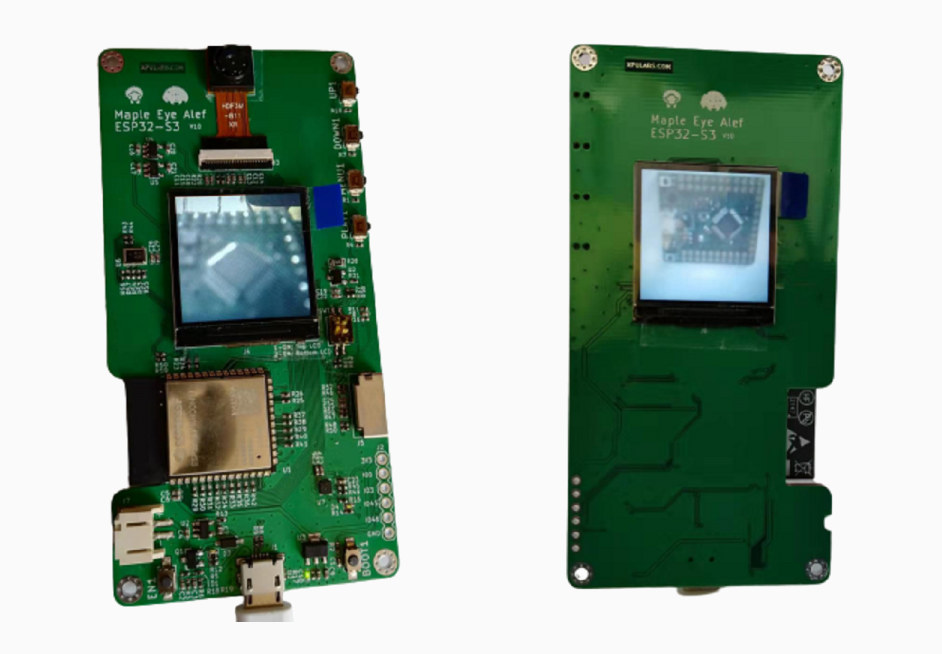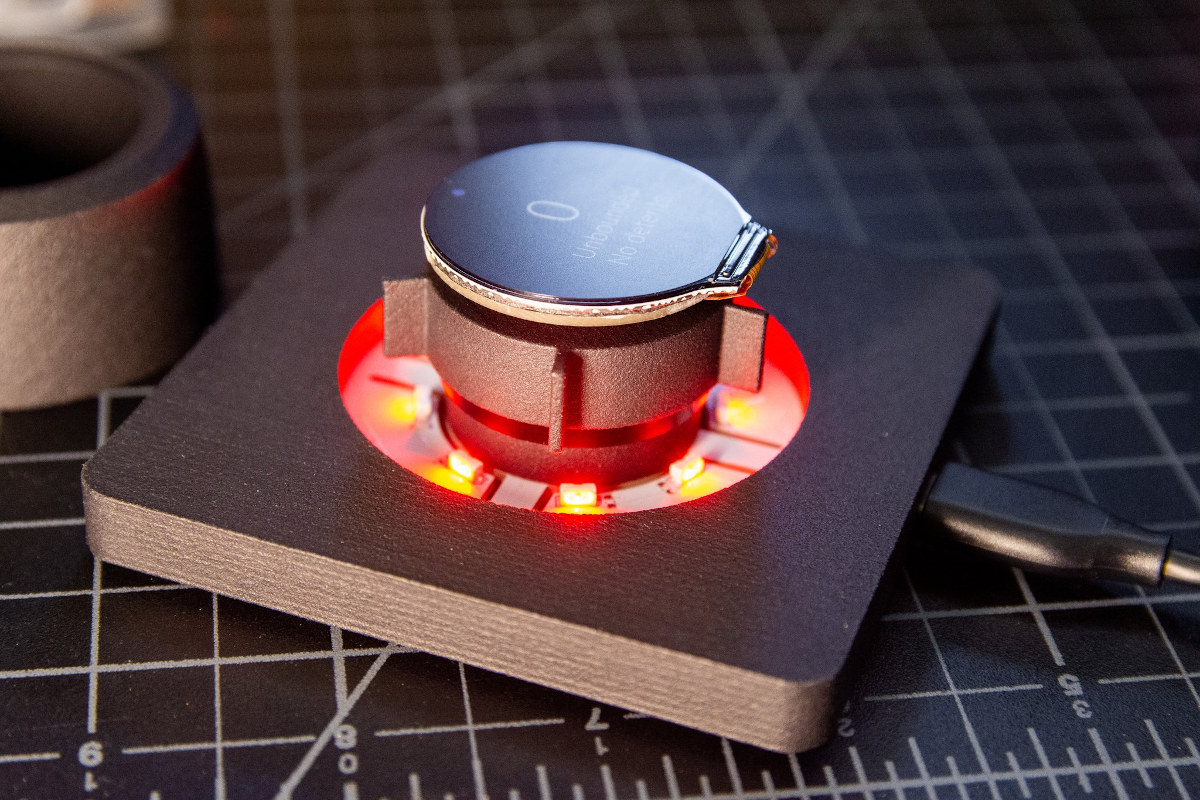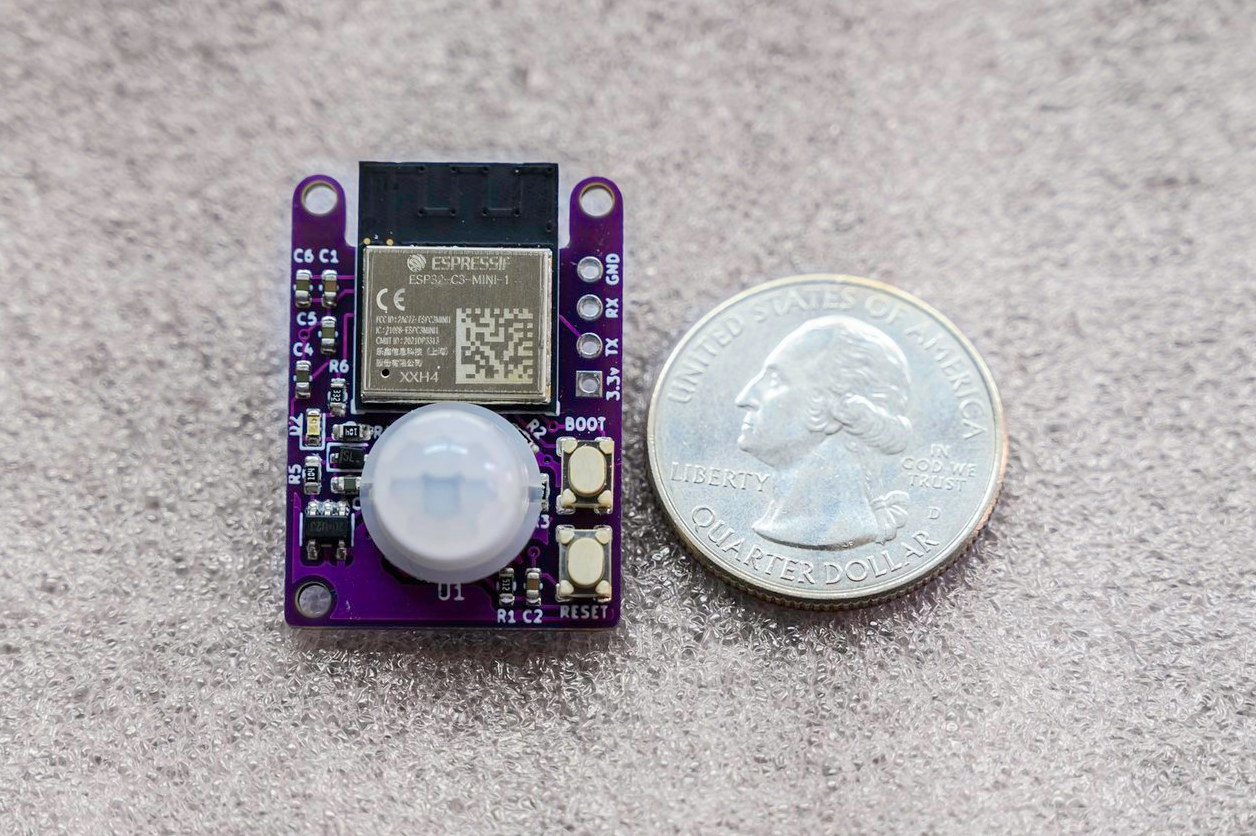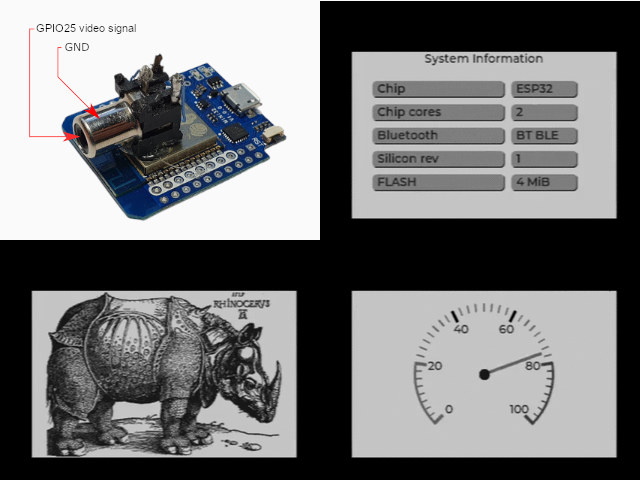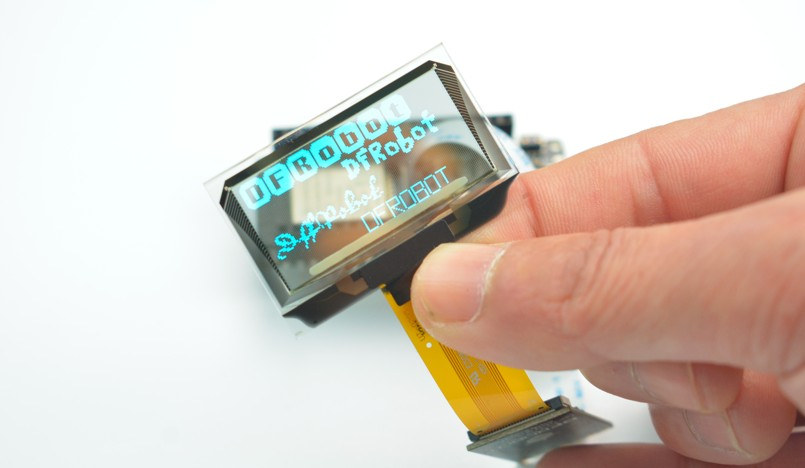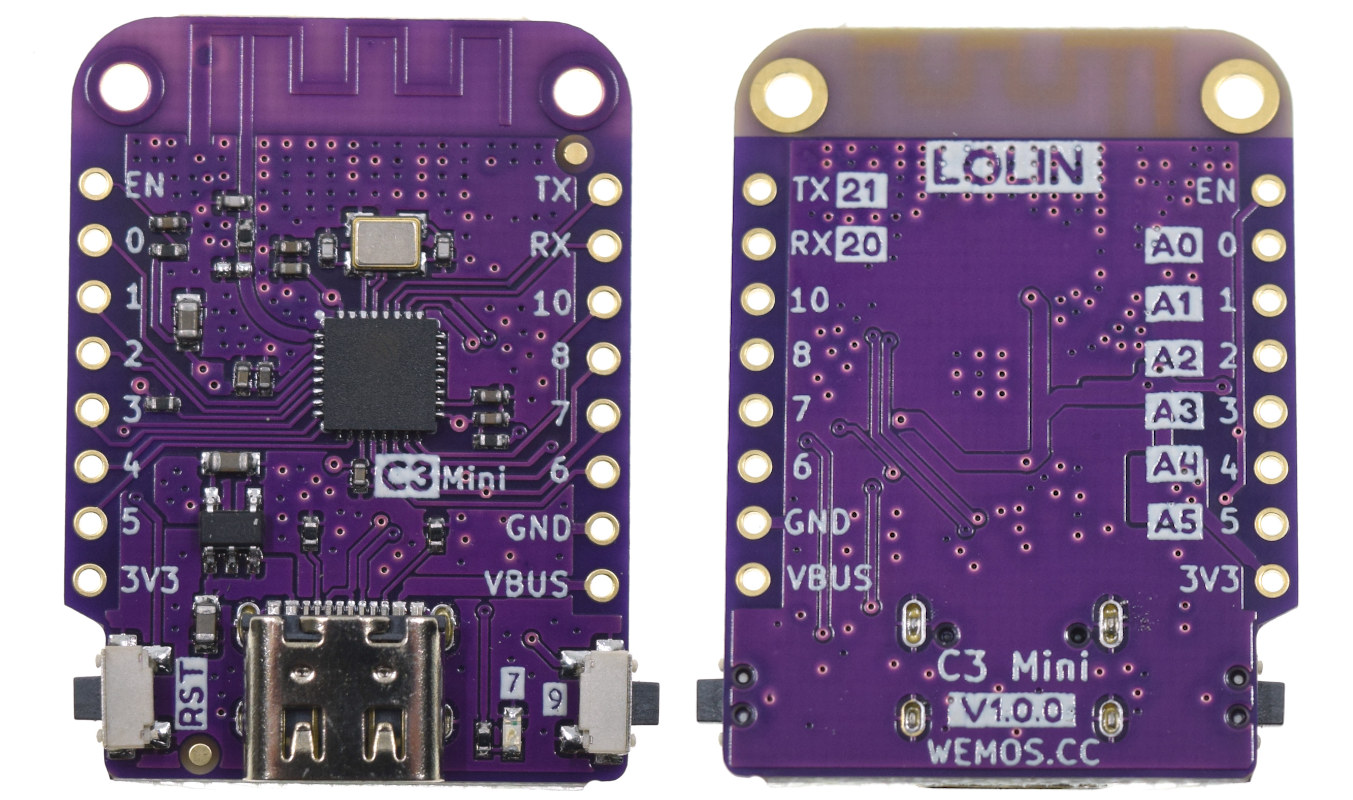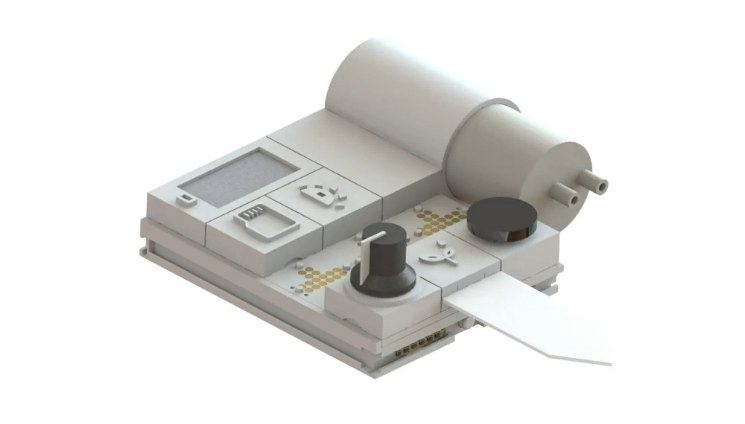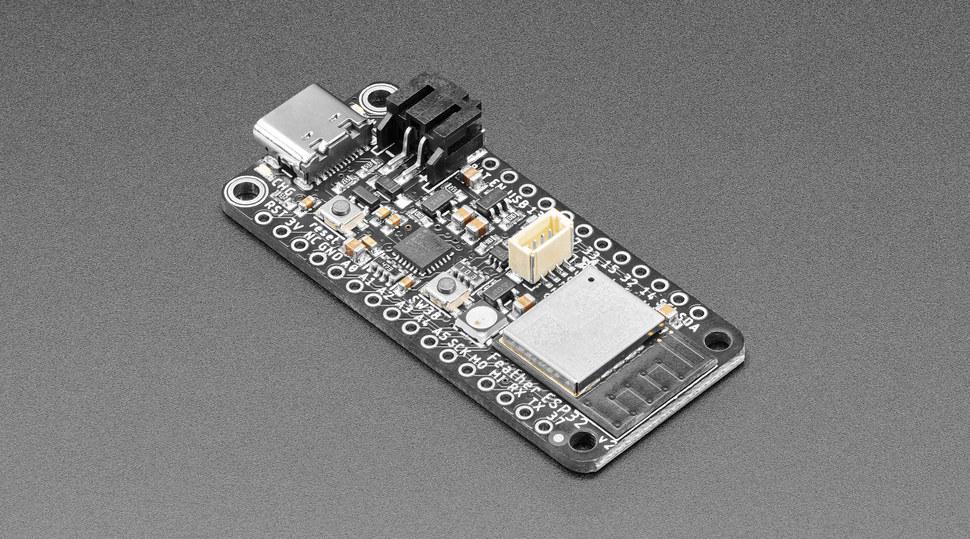AnalogLamb Maple Eye ESP32-S3 is a WiFi and Bluetooth connected board based on ESP32-S3 dual-core Xtensa LX7 microcontroller and equipped with one 2MP camera, one microphone, and two LCD displays placed on each side of the board. Those features, plus 8MB of flash and an 8 MB Octal PSRAM, allow the board to make good use of ESP32-S3 AI instructions through the ESP-DL library found in ESP-WHO framework in order to speed up face detection and recognition algorithms, or for audio processing. Maple Eye ESP32-S3 specifications: Wireless module – ESP32-S3-WROOM-1 module with ESP32-S3 dual-core Xtensa LX7 processor @ up to 240 MHz integrating vector instructions for AI acceleration, 512 KB SRAM, 8MB PSRAM & 8MB Octal SPI Flash Storage – MicroSD card interface Displays – 2x 1.3-inch TFT LCD displays, selectable by switch Camera – 2MP OV2640 camera Audio – Digital microphone for VAD (voice activity detection) & ASR (automatic […]
SmartKnob View is a DIY haptic input knob with WiFi and Bluetooth connectivity
Soon after writing about RoenDi rotary encoder with a built-in color display, readers pointed me to SmartKnob View, a similar-looking project but featuring an ESP32 module for WiFi and Bluetooth connectivity, plus software-configurable end-stops and virtual detents. The latter is enabled through a brushless gimbal motor paired with a magnetic encoder to provide closed-loop torque feedback control. Just like RoenDi, SmartKnob View comes with a 240×240 round color display but adds tactile feedback so you can change the menu when pressing the display. SmartKnob View specifications: Wireless module – LilyGO Tmicro32 Plys based on ESP32-PICO-V3-02 WiFi and Bluetooth LE SoC (May be changed to ESP32-S3-MINI-1 to enable USB HID support, once Arduino core supports it) Display – GC9A01 1.28-inch 240×240 round LCD covered by a 39.5mm watch glass on rotor Motor – BLDC gimbal motor, with a hollow shaft for mechanically & electrically connecting the LCD USB – 1x USB […]
Bee Motion Mini board combines ESP32-C3 with PIR sensor
Designed by Smart Bee Designs, the tiny Bee Motion Mini combines an ESP32-C3 wireless RISC-V SoC with a PIR sensor for motion detection reporting over WiFi, Bluetooth LE, or Bluetooh Mesh. The board was designed to be as small as possible to fit into a 3D printed case with a LiPo battery and placed/hidden anywhere you want. Motion detection range is up to 5 meters, and the Bee Motion Mini can connect to services like MQTT, ITTT, or NodeRed to trigger other devices upon motion. Bee Motion Mini specifications: Wireless module – Espressif Systems ESP32-C3-MINI-1 module with ESP32-C3 WiFi and Bluetooth LE 5.0 RISC-V SoC up to 160 MHz, 4 MB embedded flash PIR sensor – Passive infrared motion sensor with dome lens, 5-meter range I/O- UART Tx/Rx for flashing firmware, 3.3V, and GND Misc – BOOT and RESET buttons Power Supply JST PH.20 connector for LiPo battery 3.3V via […]
ESP32 Composite Video Library outputs PAL, SECAM and NTSC, supports LVGL
It’s been possible to use the I2S for video output on ESP8266 and ESP32 chips for years, but aquaticus’ ESP32 Composite Video Library is may simplify the task of outputting PAL, NTSC, or SECAM video signals from any Tensilica-based ESP32 platforms. The library does not require any external hardware, and you can just connect an RCA connector to GPIO25 (I2S data) and GND, plus integration with the LVGL library makes it easy to create graphical user interfaces as showcased with the captures below. The library supports grayscale video output (no color at this stage), multiple resolutions from 384×288 to 720×288 at up to 25 or 30 Hz, six different pixel clocks for PAL/SECAM and NTSC, as well as six framebuffer formats with namely RGB565, RGB332, Grey 8 bits/pixel, Grey 4 bits/pixel, Monochrome 1 bit/pixel, and LVGL monochrome 1 byte/pixel. You’ll find the source code for the ESP32 Video Composite […]
1.51-inch transparent OLED display works over GDI or SPI interface
We’ve seen transparent, see-through displays at least since 2010 for retail applications, and over the years, these types of transparent displays or variants have made it to consumer devices like smartwatches and notch-free smartphones. But I don’t think I had ever seen transparent displays for the maker market, and DFRobot Fermion is 1.51-inch transparent OLED display with 128×64 resolution that is connected to the host MCU via SPI or GDI (General Display Interface) interface. Fermion specifications: 1.51-inch transparent OLED display with blue pixels based on SSD1309 driver Resolution – 128×64 (transparent part: 128×56) Display interface – 8-bit 68xx/80xx Parallel, 3-/4-wire SPI, I2C Adapter Interface – SPI, GDI Operating Voltage – 3.3V Dimensions Screen Size – 41.92 x 27.08mm Display Area – 35.05 x 15.32 mm Pixel Pitch – 0.274 x 0.274mm Pixel Size – 0.254 x 0.254mm Adapter Size – 18 x 28mm/0.71 x 1.10inch Temperature Range – -40~70°C There […]
LOLIN C3 Mini ESP32-C3 board is compatible with Wemos D1 Mini shields
Wemos LOLIN C3 Mini board is powered by Espressif ESP32-C3 WiFi and BLE RISC-V microcontroller and follows the company’s earlier Wemos D1 Mini (ESP8266) and LOLIN S2 Mini (ESP32-S2) form factor for compatibility with the original stackable Wemos D1 shields. The tiny board comes with 4MB flash embedded in the ESP32-C3 chip, a USB Type-C connector, reset and user buttons, as well as sixteen through holes for GPIOs, VBUS, 3.3V, and ground signals. LOLIN C3 Mini V1.0.0 specifications: SoC – Espressif Systems ESP32-C3FH4 single-core 32-bit RISC-V (RV32IMC) microcontroller up to 160 MHz with 400 KB SRAM, 4MB Flash Connectivity – 2.4 GHz WiFi 4 and Bluetooth 5.0 LE (in SoC) Expansion headers – 2x 8-pin headers with up to 12x GPIO, ADC, I2C, SPI, UART (3.3V I/O voltage) USB – 1x Type-C USB for 5V power and programming Misc – Reset button and button 0 also used to enter Device […]
Pockit modular Linux computer gets a Raspberry Pi CM4 upgrade
We first wrote about the Pockit modular Linux computer with hot-plugging magnetic blocks about a year ago. The system was based on a STM32+ESP32 mainboard with a socket for an optional Raspberry Pi Compute Module 3 and included magnets and electrical contacts to snap and hot-plug modules/blocks while the computer is running. The developer (Anil Reddy) has made good progress with the project and added the option to use a Raspberry Pi CM4 with Pockit (provided you can find one) to improve performance, for example for computer vision. Other changes include support for AI accelerators, an improved dashboard, home automation integration, and more. Pockit now supports over 80 feature BLOCKS ranging from a rotary encoder to a microSD card reader to various camera types, an HDMI block, AI accelerators, and so on. All of which can be magnetically snapped while the computer is running, and automatically detected in the dashboard. […]
Adafruit ESP32 Feather V2 ships with 8 MB Flash, 2 MB PSRAM, USB-C port, and more
Adafruit ESP32 Feather V2 (aka Huzzah32 Feather V2) is an upgrade to the company’s HUZZAH32 ESP32 Feather, still based on ESP32 WiFi & Bluetooth processor, and designed with the initial goal of replacing the obsolete CP2104 with the CP2012N USB to TLL chip. But Adafruit ended up doing a complete redesign with extra storage (8MB flash in total), 2MB PSRAM, a USB-C port replacing the Micro USB port, an extra tactile switch, an RGB LED, lower power consumption, and more. Adafruit ESP32 Feather V2 specifications: Wireless module – Espressif Systems ESP32-PICO-Mini-02 (PDF datasheet) with an ESP32 dual-core Xtensa processor @ up to 240MHz with 2.4 GHz WiFi and Bluetooth Classic/LE, 8MB flash, 2MB PSRAM, PCB antenna, FCC/CE certification. USB – USB Type-C port for power and programming via CP2102N chipset I/Os 16-pin and 12-pin GPIO headers with GPIOs, analog inputs, I2C, UART, SPI, DAC, etc… STEMMA QT connector for I2C devices, […]


